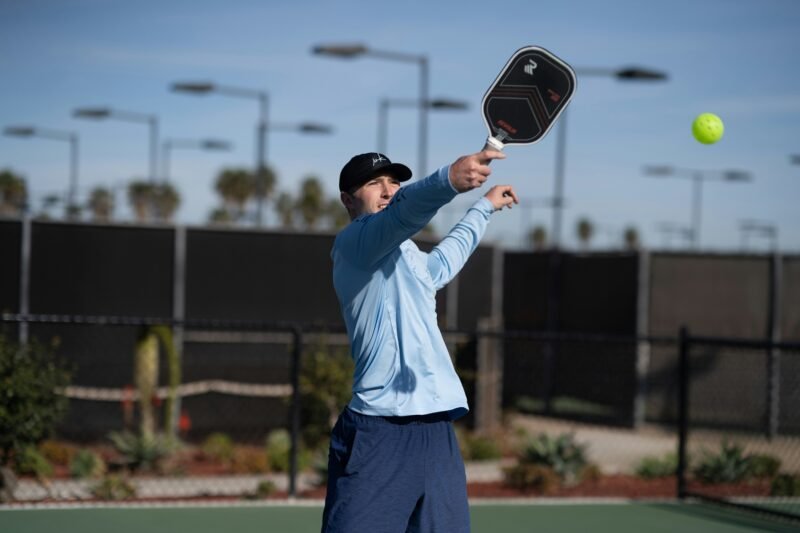Pickleball Player Ratings Explained (DUPR/UTPR)
Prefer to listen? Tap play below!
Pickleball is one of the fastest-growing sports in the United States and elsewhere, and for good reason. The fusion of tennis, badminton, and ping-pong offers a fun blend that all sorts of people love. But as more games continue to be played, there’s one crucial thing that serious competitors should know more about, your player rating. Here’s why.
Your player rating is whichever of the following applies:
- Dynamic Universal Pickleball Rating (DUPR)
- Universal Tennis Pickleball Rating (UTPR)
The “Dynamic” in the Dynamic Universal Pickleball Rating (DUPR) means that the upper rating for a player to which it is being applied will tend to go up and down as they win or lose in recent matches. In contrast, the Universal Tennis Pickleball Rating (UTPR) are “Universal Tennis” implying the same stability that can be seen when viewing the whole’s history.

How the scores are actually calculated is hidden behind their systems. All we know is that if you perform well in matches, your scores will go up. If you win against opponents that are a higher rating than you, your score will jump higher than if they were rated lower than you. Keep this in mind when signing up for tournaments and DUPR rated matches / open play.
What Are Pickleball Player Ratings?
Pickleball player ratings are a standardization that ranks players based on skill level. They’re usually given as an assessment of how you have played in past games, what your performance is like, and potential evaluator for coaches and tournaments. But for the most part, they are given as a numbered rank ranging from 1.0 (beginner level) to 5.0 (advanced and above according to the USAPA ratings). It’s good to know exactly where you rank as a player.
The obvious purpose of this rating is to test your skill correctly and find out where you need to improve. Most players aren’t very good with a rating of 1.0 (beginner’s that are starting at the ground level) but it is not uncommon to see new players trying out pickleball with a higher rating because they have played the game before. Either way, your rating directly correlates with how long and well you have played.
Enter your skill ranking into the chosen tournament. You will be placed in a bracket with players who are similar to your skill level, you will be given an opportunity to play your best, and you will definitely have fun. Not having to be placed in the exact same bracket as everyone else is nice, competitive games are much more fun to watch, and definitely improves happiness in the courts.
Understanding DUPR (Dynamic Universal Pickleball Rating)
Dynamic Universal Pickleball Rating (DUPR) is a new, exciting system with one goal in mind, to provide accurate and fair player ratings for the sport of pickleball. The system allows for a standardized rating that all players, new and experienced, can turn to when they want to participate in a fun match that they know will be competitive and equitable.
The algorithm used to calculate player ratings is complex in that it takes into account numerous variables, but is simple in that it provides one single rating that is easily understandable and intuitive and can be used in any format, recreational or tournament, in which the player is deciding to participate.

Moreover, the system is “dynamic”, which means the users’ ratings are updated after every match, and the rating readjusts, recalculates, and reassigns the users’ new rating in real-time. The players use their new rating to provide an accurate depiction of their skills’ current level. No player is expected to maintain the same level of play throughout their career. The dynamic rating allows for the players to develop and adapt, while their rating reflects their overall pickleball skills and abilities.
Exploring UTPR (Universal Tennis Pickleball Rating)
The Universal Tennis Pickleball Rating (UTPR) is a new standardized rating system that assesses the skill level of pickleball players. The UTPR, fondly named after its tennis community origins, was created to provide a similar, consistent rating of every player (like the Universal Tennis Rating (UTR) in tennis), in order to grade or give “a number” to the skill level of each and every player. Ratings often seem to be used as benchmarks or a number to set a goal to improve upon. And, of course, it is easier to find the best competition for your or my skill level, once you know what that is.
So what’s the difference in UTPR and DUPR, you might ask? Basically, just the method and application of how the ratings are developed. The UTP rating is based on player performance and is backward looking. Each system uses a “secret” algorithm (mathematical formula) to develop each individual’s player rating, in which players are not provided the actual formula, except to provide that the UTPR system is based on head-to-head matches with other rated players, and that it is “result based.” There are many, many more data points that could be captured and applied to each rating system; however, the UTR/UTPR system does not capture any of them. Here are some interesting differences worth noting here. In UTPR, you only receive a “point” if you win the match against a higher rated player. The DUPR system appears to capture all games won, such as a “point.” In the DUPR system, every win will increase your score even if it’s just a little.
How to Improve Your Pickleball Skill Level
Knowing where you currently stand in terms of your DUPR (Dynamic Universal Pickleball Rating) or UTPR (Universal Tennis Pickleball Rating) is critical. Reflect on your play to help identify areas of improvement. Think back to your recent games. How did you do? What was your record against the same, lower, and higher rating players? Incorporate solo and pair drills into your training. Aim to play ranked match play every week. Put your refined skills to the test. Compete. For many players, the competition aspect of their training gets the juices flowing. This can be just what is needed to make your competitive spirit kick in. The rating system is a reasonable estimation of a player’s skill level. Continue to work on skill (and rating) development for players at all skill levels. Simply being aware of your rating can often assist you in finding a better way to enjoy your pickleball experience. No one enjoys playing where one player, or more than one player, is clearly not in the same class. Practice with an understanding of what deficiencies you possess. Many higher-level players, regrettably, are not much higher-level. Let your partner know your strategy and work as a team.
Frequently Asked Questions About Pickleball Ratings
DUPR (Dynamic Universal Pickleball Rating) and UTPR (Universal Tennis Pickleball Rating) are important indicators most players become familiar with early on in their game. Essentially, they determine a player’s level of skill at that particular time. The thing that often confuses people is when and how these scores become assigned. For the most part, they are calculated after each match the player participates in. That means players’ scores in the initial part of a tournament could be quite different from what they look like at the very end. DUPR usually updates scores after every game. UTPR tends to update after an entire tournament is over. Sounds simple enough, right?
A couple of things to keep in mind. Your score really doesn’t necessarily reflect just the level of skill you currently have. Specific matches and even what an opposing player’s score currently is will affect what your score ultimately becomes. In time, even that score will change, as well. We’ll go into more detail on that in a little bit! So, take your number with a grain of salt.

These ratings are metrics that help provide an objective measure for a player’s results in pickleball. In doing so, the measure allows you to compare yourself to the other hundreds of thousands of pickleball players who use the system to understand how their performance stacks up against the field. This information will help you find what you need to work on to improve your game relative to your peers.
If you know where your rating lies, you will have some idea of the things you need to work on. Accordingly, “practice” should be an important part of your game, even if you are not certain you know how to play pickleball but know your rating. Let this information help guide your practice sessions. For example, you might find that you could better work on improving your pickleball strategy, serve, or just basic footwork.
If your practice sessions are tailored to help you improve your game enough to see growth in your pickleball rating, try to practice consistently with players of your new skill level and, again, try to compete in as many local events as you can. Developing the sport is one step to improving at the game. Again, this will give you the opportunity to experience the fun of competition and the feeling these types of events give you. Not only that, but you will in all likelihood also meet a lot of good people, which doesn’t hurt.
Play rating contributes to the enjoyment of the sport’s competition and a sense of community. Occasionally, you’ll have to ship a friend a shirt when they get that first tournament under their belt, but you will, overall, create a game environment that pushes you to have to perform at a high level. Hopefully, with that balance, you will enjoy seeing picklers you know get to that elusive better and better play rating. Use these skills and drills to elevate your DUPR/UTPR scores.
Other Articles
Pickleball Drills to Improve Net Play
Pickleball Tournament Prep Checklist
Pickleball Tips for Playing Indoors
Pickleball Drills for Better Reaction Time
How to Build a Backyard Pickleball Court
Pickleball Strategy for Windy Conditions
Pickleball Paddle Grip Techniques
Improve Pickleball Serve Accuracy
Pickleball Doubles Positioning Tips

